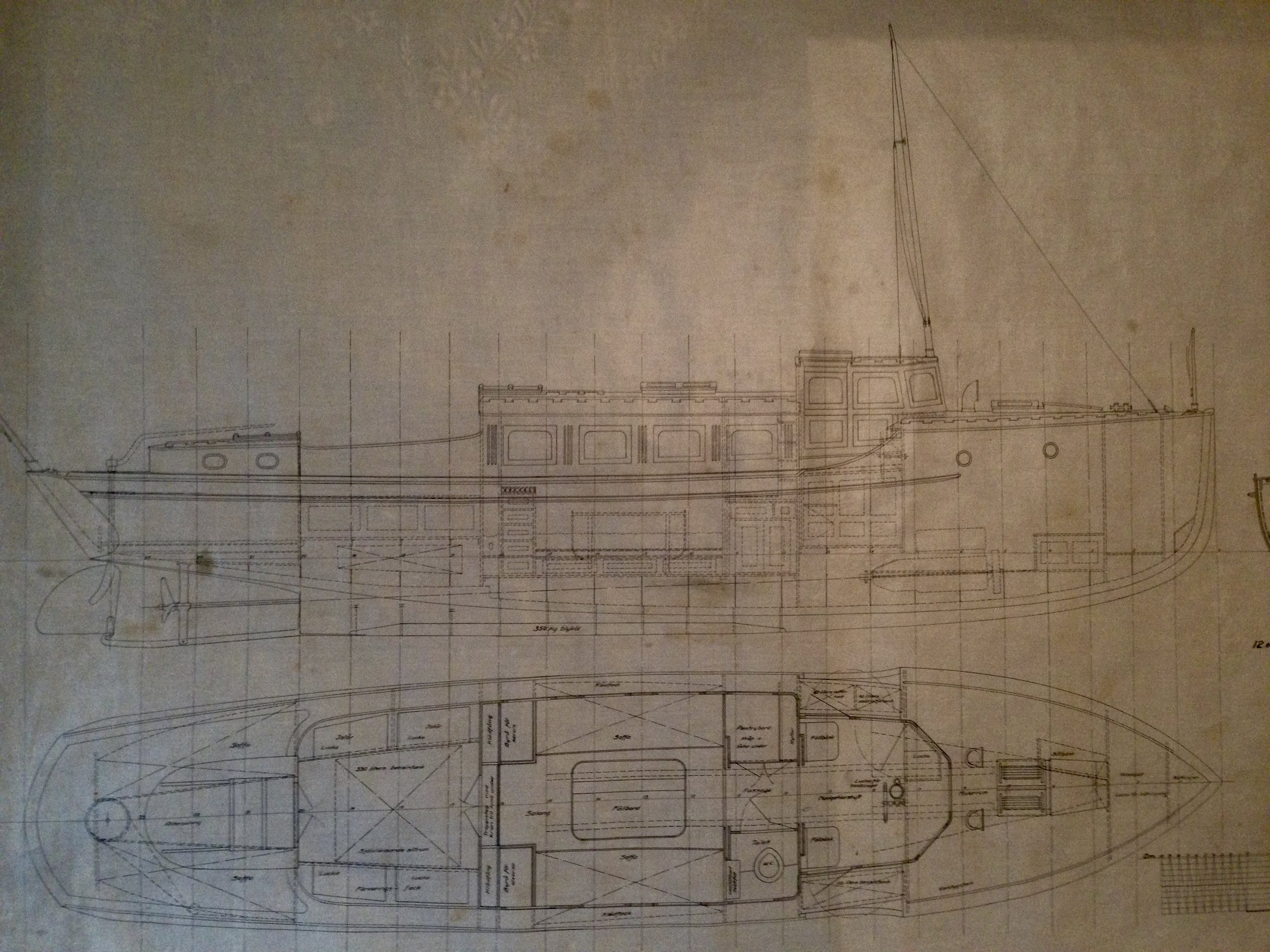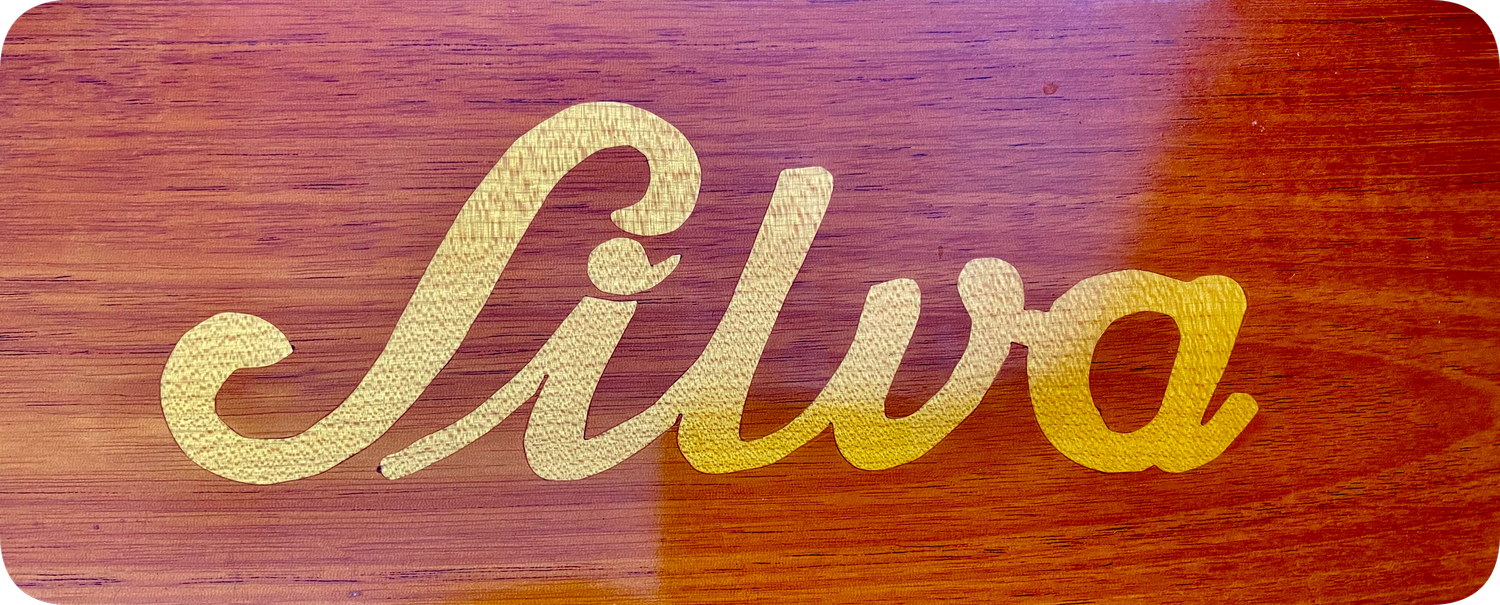
CG Pettersson
Drawn by CG Pettersson, drawing dated 18 April 1923 with number 630 A and B.
LoA 12,60 m
width 2,60m
depth 0,85 m
displacement 5900 kg
Top speed 13 knots, cruising speed 8 knots and then with a fuel consumption of 0.5 liter per nautical minute with the current engine which is a 4 cylinder Yanmar diesel 4JH3G-HTG with 100 horsepower
Original Wisconsin 6 cylinder gasoline engine with 35 horsepower and weighed 700 kg without reverse gear.
Engine No. 2 was a 125 horsepower Kermath that came in 1929.
Engine No. 3 was a Penta EC 6 with 75 horsepower. When we bought the boat in 1995 we got a Volvo md 47 with engine but it was on a stool next to the boat that probably never sat in the boat. It is likely that the boat's owner realized that the boat was in very poor condition when this engine was to be mounted and then Silva was left standing there on the harbor in Lomma in the early 1970s
The 250-liter stainless steel diesel tank offers a range of 500 nautical mile at cruising speed
260 liter of fresh water in two separate stainless steel tanks
6 berths and then the two of these in the forepeak can be folded together
6 pieces lead-acid batteries of 70 amps each and since one of these is only intended to start the engine, they are placed under the floor in the forepeak to compensate for the today much lighter engine than the original's 700 kg
1 fuel cell that can charge our batteries with 140 amps per day
49-liter fridge and 85-liter fridge-freezer
Hydronic heating heated by a diesel boiler or shore power
Running heating with exhaust system in steering position/sedan
Hot water is available both in the kitchenette and in the toilet
Parts of original porcelain from Rörstrand
Support sails are now also on board. (Thanks Per)
We also have CGP's original drawings by Silva, these are executed in ink on waxed linen cloth and are to be regarded as pure works of art.
The dinghy that stands on the roof of the saloon is a so-called Plym dinghy, where we store canopy, fenders, etc. Goes by the somewhat irreverent name of the ceiling box
An electrically powered (4 horsepower) bow thruster has been installed for a couple of years now. Which has meant that a certain calm has appeared on board in crowded harbors and locks.
Or as Viola likes to put it, "Do you have problems with your marriage? buy a bow thruster".
Built at Landin & Johansson's shipyard in Långedrag 1923-1924 for GV Rundström, Gothenburg. There are reports that the shipyard went bankrupt in 1924 and that SILVA was left half-finished while the affairs were sorted out. And possibly also a relocation of the entire shipyard's operations to Önered.
Silva was built in Honduran mahogany in the hull, every 3rd steel frame and then we call it a composite build which was very common in Sweden at this time. It gives a strong and light hull with keel and stems in oak. Braces and deck beams in ash. Silva also has a lead keel of 320 kg. Today, about 70% of the bottom is made of northern heartwood. As well as the galvanized iron frames and bottom logs replaced with new stainless steel, a total of 48 pieces and 24 pieces of bottom logs and all screws and rivets that hold them in place.
The construction of Silva is described with drawings in “Seglarbladet” 1924 no. 8 & 9.
Silva has been parked on land in Lomma south in Sweden from the beginning of the 70's until 1995. Where our best friend Erik saw her on the harbor floor with a sign for sale nailed to the bow when he was down to visit his future wife Karin. Transported to Ekerö on a truck in the autumn of 1995 for renovation and relaunched on 2 Nov 2001. During these 7 years, more than 9 thousand man hours were spent on the renovation. After the launch in 2001 we have, among other things: Built interiors in the forepeak and aft cabin, the bow and aft deck have been relaid in solid Oregon Pine ribs that are conical thus wider towards the middle of the boat. Also changed to faceted glass in the saloon sides. So with this, we have passed ten thousand hours with a good margin to restore our Silva in a good condition.
After the renovation, we have visited all the countries in Scandinavia and in Sweden we have visited the High Coast a few times and further up to Holmön/Umeå, Vänern and Vättern, the Gothenburg archipelago, Skåne and Blekinge, Dalsland's, Falsterbo and Kinda canals and the Göta canal several times and then Glafsfjorden up to Arvika.
Length of ownership.
1923-1960 GV Rundström, Göteborg
1961-1968 Lars Olsson, Malmö
1969-1970 Jonny Petersson,Calle Bergström,Dennis Olsson, Lomma
1971-1975 Roland Pirrå, Limhamn
1976-1988 Konsortiet Niklas Jonsson, Lomma.
1988-1994 Karl Erik Ohlsson, Lund
1995- Anders och Viola Widström, Ekerö
Listed
Listed The saloon motorboat Silva has been listed in 2012 by the Maritime Museum.
Text from the Maritime Museum's website:
"Silva belongs to the older generation of pleasure boats, which were produced in one copy with their own drawing. Over the years, it has undergone some rebuilding. After more than 15 years on land, the current owners have carried out an extensive necessary renovation. Thanks to the owner's experience and the surviving documentation, the result has been a boat that now has a close appearance to its origin. The documentation material shown by the owner, including photographs, makes it possible to follow the history of the boat in a commendable way. Overall, the National Maritime Museums consider Silva to be culturally and historically valuable and meet the requirements to be considered a listed pleasure boat.
Built in 1923, owner lives in Ekerö, Stockholm County
Type: Saloon motorboat
Structural engineer: C G Pettersson (drawing no. 630)
Built: 1923 at Landin & Johansson, Långedrag
Material and dimensions: Wood, length 12.60 m, width 2.60 m. Engine: Yanmar 100 horsepower, originally a Wisconsin petrol 6, 35 horsepower”
Silva in Dalslands channel 2018
Stockholms out most archipelago 2021




